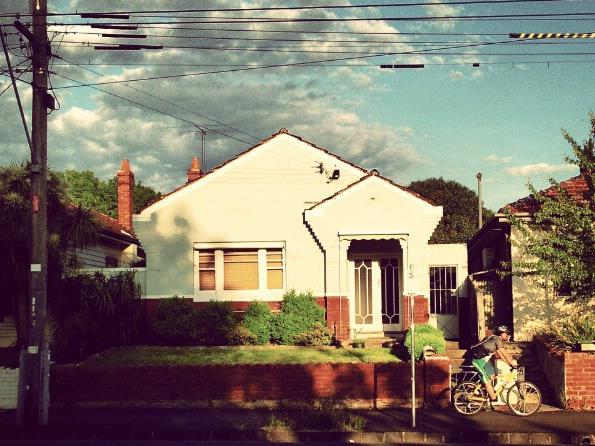The great Australian dream of the half acre block within 5km of the city is simply unrealistic. Photo: A cyclist travels past a home in Brunswick East, Melbourne. Credit: Sarah Adams.
The demand for property throughout the Australian capital cities is exceeding the supply and it is causing a crisis. Not only due to the diminishing availability but also due to the rising costs involved when moving dwellings. What has resulted is almost akin to a lottery system, with competition generated at auctions before much of the bidding war has begun.
There is no real movement or diversity within the market, no wiggle room for younger generation to enter the race. Thomas the Think Engine has written a wonderful and concise piece that showcases just what is occurring and will continue to transpire if we proceed down the same path.
Financially, owning a half-acre block is unrealistic. Many save years to build up a deposit, let alone the hefty stamp duty. Mortgages take decades to pay off and those that are unable to do so face a struggle to rent in an extremely competitive rental market. The bottom line is that low-density housing does not provide a viable living model for the future, unlike its medium or high-density counterparts.
What medium or higher-density living offers is an entirely new living model. If designed and executed carefully and with the utter most consideration, it is able to provide living spaces that house not only many residents but also the services and recreational amenities needed for like-minded occupants, all while ideally being located close to common workplaces and attractive social hubs. This is done by using smaller areas of ground land but stacking elements vertically, becoming more volumetrically successful and beneficial if able to provide green space between living quarters, an outlet and haven away from the busy surroundings.
Increasing the density of areas is also able to apply pressure to local governments and change the outcome of how a city is designed and used as an urban space. You need only look at the rapid development of areas such as Richmond by the Yarra River (in Melbourne) to see the enormous impact a change in density has and will continue to cause on local life and infrastructure for both better and worse.
This is not to suggest that we build humongous conglomerates of apartments and I certainly don’t encourage it in locations where it may impact the natural landscape, but I do think it serves as a marker to prove that more can be done with the plots of land that inhabit our inner city band.
Yet, Australians seem to have an intense aversion to varied density living and this is not entirely unwarranted.
There are two critical drawbacks. Firstly, current infrastructure does not support any real transition to newer forms of living. Much of the public transport, particularly in major cities like Melbourne, is already crammed beyond belief. Not only is public transport maxed out, inhibiting the encouragement that would lower excessive automobile usage, but so are the basic physical and organisational structures needed to operate a flock of inhabitants – hospitals, schools, roads etc. This is where more support is needed. No change can be made by any council or government without the demand and pressure from both those inside and the ones funding it, us, the taxpayers.
The second issue and possibly the most prevalent, is the mindset and stigma attached to varied density living. People find change hard. This is especially true when it does not agree with what has been instilled upon them.
What people don’t realise is that while we are all cooped up in our single houses, hacking at our mortgages, working more than we ever have before, we have very little time to interact with our places of residence, let alone the other people in these situations- our neighbours.
It may be hard to embrace the move to higher density living to begin with; however, the benefits include greater interaction between people in places and communities. A choice in lifestyle options, with lesser responsibility attached to that of single dwellings. Convenience, if well designed with close access to amenities, transport and services. The capacity and ability to commute by cycling and walking is also increased, which in turn is cheaper, healthier, more sustainable and efficient than commuting by car.
We must support the creation of clusters of self-sufficient neighbourhoods and look to examples such as that in other cosmopolitan cities such as Berlin, Hong Kong or Tokyo.
Berlin, offers an example of where most residents reside in medium-high-density apartment communities, clustered around the centre and fringe of the city, forming almost a sub-suburb feel. This style of living, like Hong Kong’s, takes advantage of a different housing model, where apartments share common spaces such as gardens, household facilities (laundries etc) and even playgrounds. This becomes even more successful with the integration of a strong transport system causing many residents to have no reason for owning a car. Neighbours also interact with each other over spontaneous meetings rather than abstaining. Such connections and living conditions cannot be formed in the sprawling low-density housing Australia continues to support.
We must identify that the Australian dream is not a feasible solution for the future and that in order to create a more liveable, comfortable and of course affordable country, we must adapt to new styles of living. Even if it means sacrificing that luscious backyard.





